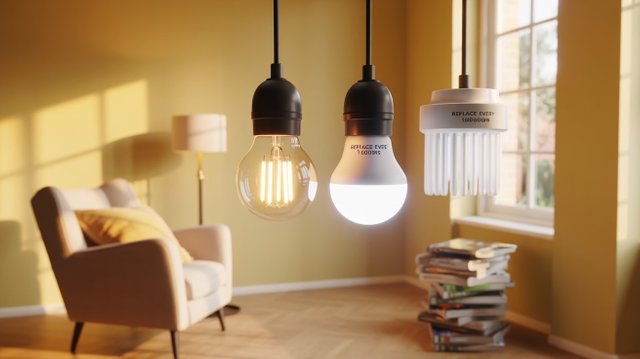How Often Should You Replace Light Bulbs in Your Home?

Light bulbs are an essential part of every household, providing illumination and creating ambiance. However, understanding when to replace them can be tricky. In this comprehensive guide, we delve into the factors that affect the lifespan of light bulbs, how to identify signs of wear, and the importance of regular replacement to maintain a safe and efficient home.
Factors Affecting the Lifespan of Light Bulbs
The lifespan of a light bulb depends on several factors, including its type, usage, and environment. Here are the main considerations:
- Type of Light Bulb
Different types of light bulbs have varying lifespans:
Incandescent Bulbs: These traditional bulbs typically last between 750 and 1,000 hours.
Compact Fluorescent Lamps (CFLs): CFLs are more energy-efficient, lasting up to 10,000 hours.
Light Emitting Diodes (LEDs): LEDs are the most durable, with a lifespan of 25,000 to 50,000 hours.
Halogen Bulbs: Halogen bulbs generally last between 2,000 and 4,000 hours.
- Usage Patterns
Frequent on-off cycling can reduce the lifespan of certain bulbs, especially CFLs. Conversely, leaving bulbs on for extended periods can cause overheating, shortening their life.
- Environmental Factors
Extreme temperatures, high humidity, and vibrations can negatively impact the longevity of light bulbs. For instance, outdoor bulbs are often exposed to harsher conditions and may need replacement more frequently.
Why Regular Replacement is Important
Regularly replacing light bulbs ensures optimal brightness, energy efficiency, and safety. Over time, bulbs can dim, consume more energy, or pose electrical hazards due to wear and tear. Proactive replacement minimizes the risk of accidents and maintains the aesthetic appeal of your living space.
Need Professional Help?
If you’re unsure about replacing bulbs yourself, it’s best to consult professionals. For residents in Singapore, services like Electrician Singapore offer expert light bulb replacement. They provide quick, reliable, and affordable solutions for all your lighting needs. For more information, click here.
How to Determine When to Replace Light Bulbs
Here are some signs that indicate it’s time to replace your light bulbs:
- Dimming or Flickering
A flickering or dim light bulb often signals that it is nearing the end of its life or experiencing electrical issues.
- Frequent Burnouts
If a bulb burns out repeatedly, it might indicate an issue with the fixture or wiring rather than the bulb itself.
- Physical Damage
Cracks, discoloration, or corrosion on the bulb’s base are signs that it should be replaced immediately to prevent hazards.
Tips for Maximizing the Lifespan of Your Light Bulbs
To make the most of your light bulbs, consider the following tips:
- Choose the Right Bulb for Each Room
Select bulbs based on the function of the room and the fixture’s requirements. For example, use LEDs in high-traffic areas for their durability and energy efficiency.
- Use Dimmers and Timers
Dimmers and timers help regulate the intensity and duration of light, extending the life of bulbs.
- Regular Maintenance
Clean bulbs and fixtures regularly to remove dust and debris, which can affect performance and heat dissipation.
- Install Surge Protectors
Surge protectors guard against power fluctuations that can damage bulbs prematurely.
Replacing Light Bulbs in Different Areas of the Home
Each area in your home may require unique considerations for bulb replacement:
- Living Room and Bedroom
These areas benefit from warm, dimmable LED bulbs to create a cozy atmosphere. Replace bulbs every 3 to 5 years or as needed.
- Kitchen and Bathroom
Bright, daylight LEDs work best in these spaces. Due to higher usage and exposure to humidity, replace bulbs more frequently, approximately every 2 to 4 years.
- Outdoor Spaces
For outdoor lighting, choose weather-resistant LED or halogen bulbs. Check and replace them annually to ensure proper illumination and security.
Understanding Energy Efficiency and Cost Savings
Switching to energy-efficient bulbs, such as LEDs, can reduce electricity costs significantly. While these bulbs have a higher upfront cost, their long lifespan and energy savings make them a cost-effective choice in the long run.
Common Mistakes to Avoid
Here are some common pitfalls when replacing light bulbs:
Using Incorrect Wattage: Ensure the bulb’s wattage matches the fixture’s requirements.
Ignoring Compatibility: Verify that the bulb type is compatible with the fixture.
Skipping Safety Precautions: Always turn off the power and allow the bulb to cool before replacement.
The Environmental Impact of Light Bulbs
Disposing of old bulbs responsibly is crucial for minimizing environmental impact. Here are some tips:
Recycle CFLs: CFLs contain small amounts of mercury and should be recycled at designated facilities.
Dispose of LEDs Properly: While LEDs are more eco-friendly, they should still be recycled to recover valuable materials.
Conclusion
Replacing light bulbs regularly is essential for maintaining a well-lit, energy-efficient, and safe home. By understanding the lifespan of different bulbs, recognizing signs of wear, and adopting best practices, you can ensure optimal performance and longevity. For professional light bulb replacement services, consider contacting experts like Electrician Singapore. They provide reliable and affordable solutions tailored to your needs. Click here to learn more and schedule an appointment.